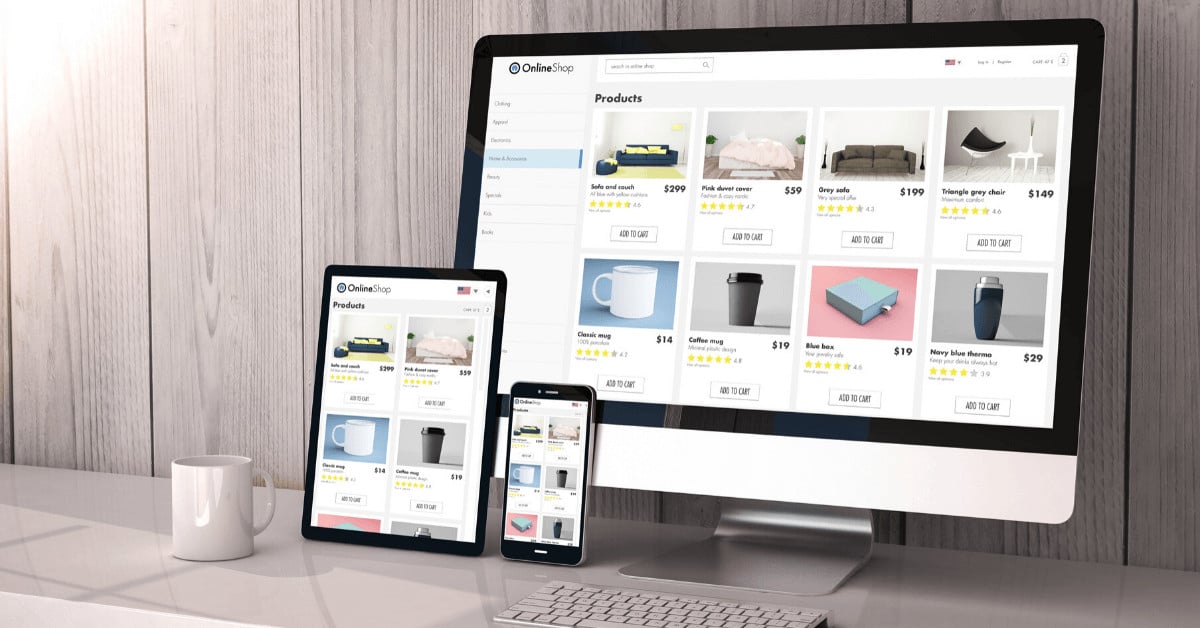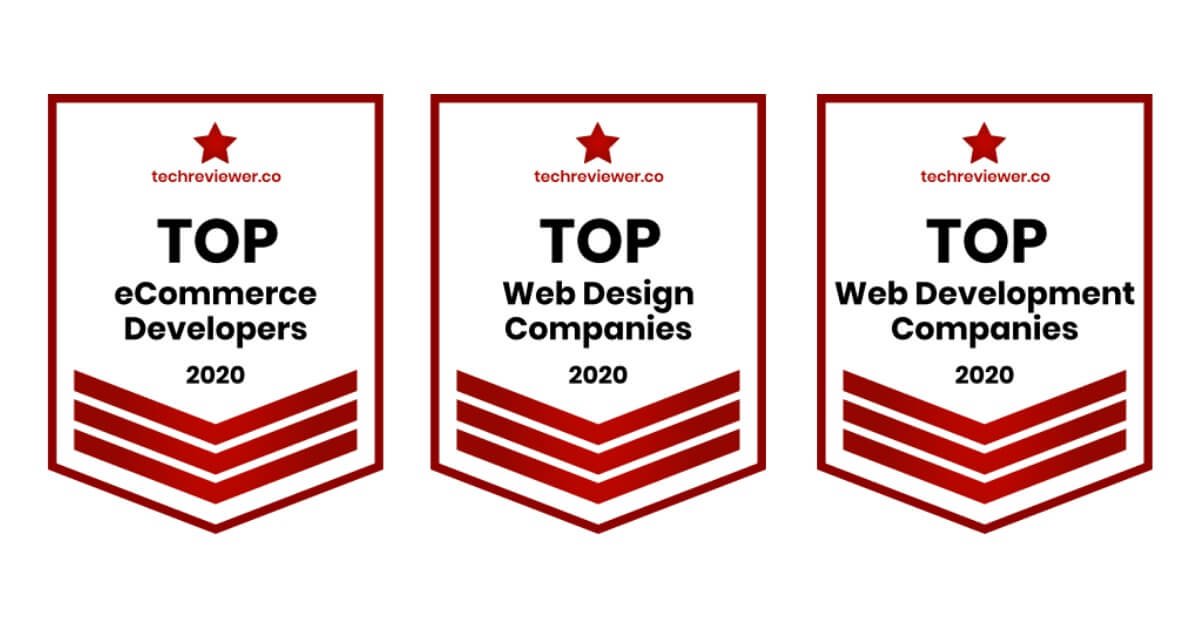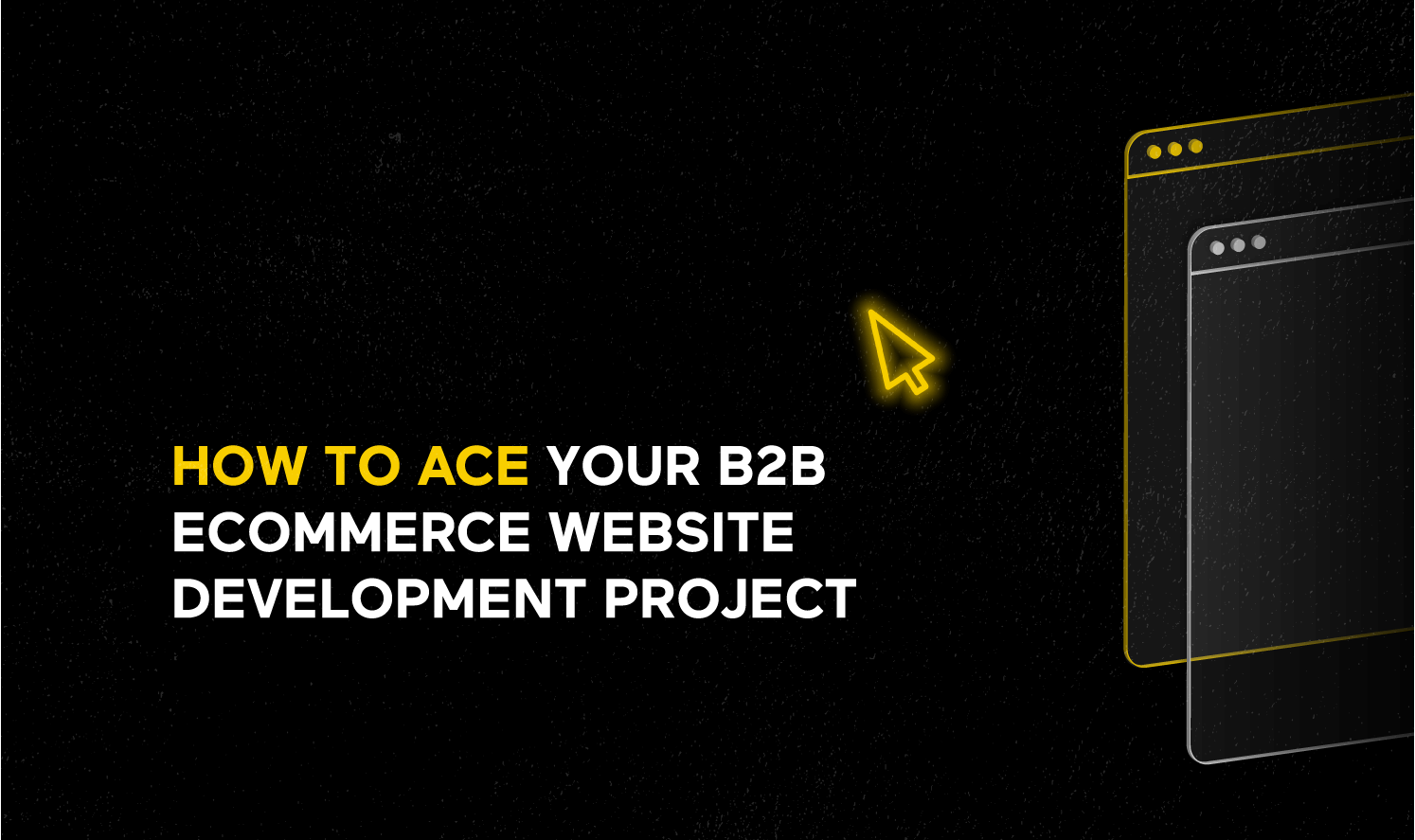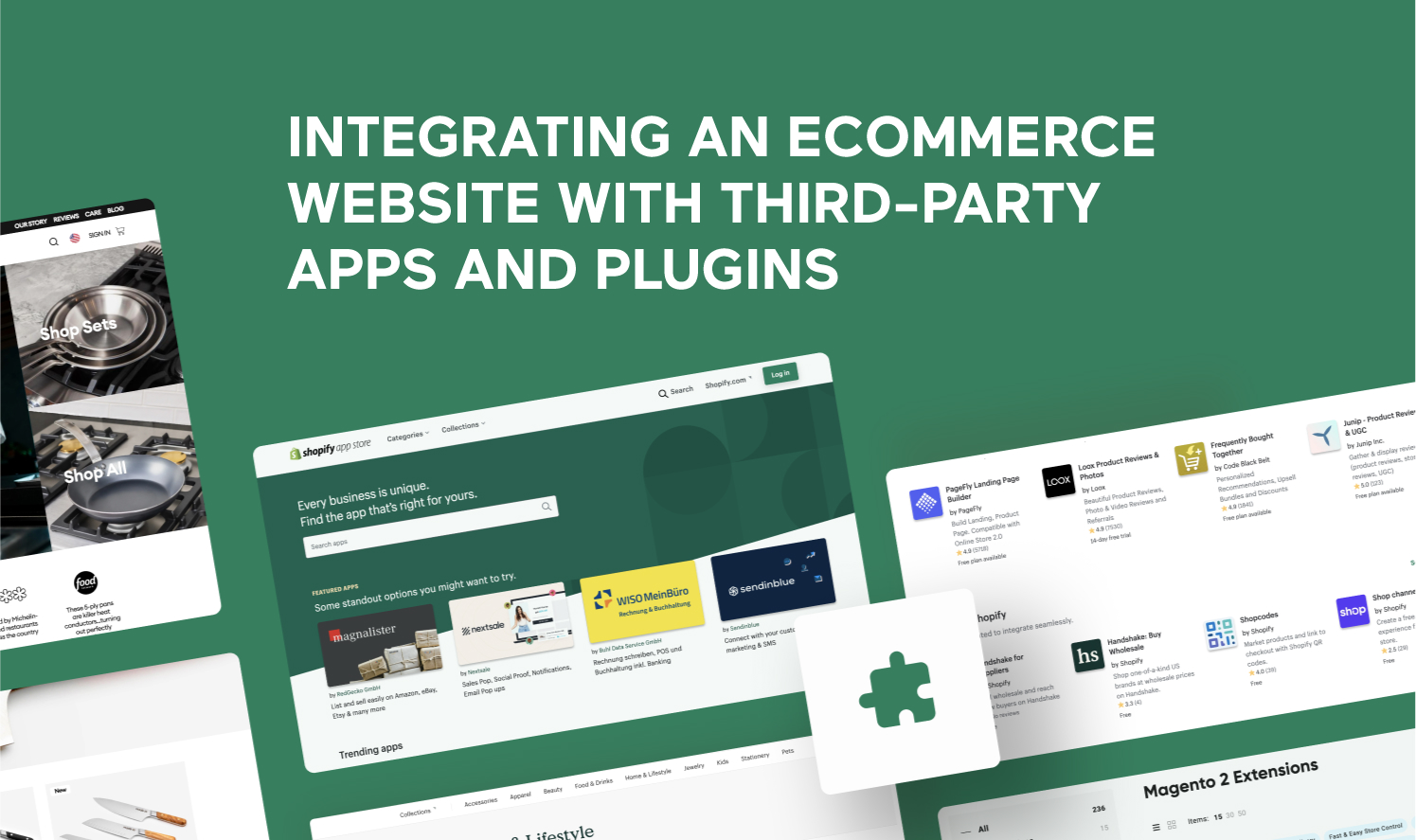How Much Does Building an E-Commerce Website Cost?
Did you know that consumers spent $601.75 billion with U.S. merchants online in 2019 — almost a 15% increase from the year prior? And experts estimate this number to continue growing as consumers modify their buying behavior, especially in 2020.
While the world spins in response to the COVID-19 crisis, many merchants selling non-essentials like loungewear and home goods are experiencing a significant increase in online sales. At the same time, online sales of essential items, like groceries, are also seeing an unprecedented triple-digit growth. Quarantine and social distancing have driven typical in-store retail customers online looking for the things they need and want, making e-commerce websites more critical than ever before–and not just any e-commerce website.
Responsive online stores that customers can easily shop at no matter what device they are on, tablet, smartphone, or laptop, will play an important role in beating out the eCommerce competition in 2020. The Pew Research Center reports that 81% of Americans now own a smartphone and by 2024, Business Insider projects that U.S. mobile retail commerce, or m-commerce, will make up 44% of all eCommerce sales. It’s clear to see that any brand that wants to stay relevant in the digital age, attract more customers, and generate more sales needs a mobile-friendly eCommerce website.

Companies need to craft an online presence that captures every aspect of the shopping experience in a smooth, engaging, and secure way. In particular, if your products or business model requires special functionalities in your online store, if your brand has outgrown off-the-shelf solutions, or if you want to stand out with a unique user experience — you will need a custom eCommerce website.
Building a custom eCommerce website can be quite a challenge for a non-technical user or someone who doesn’t have a web design and development team. If you don’t understand the cost implications of the various options, you could be spending a lot of time and money with very little to show for it at the end.
In this article, we’ll discuss in-depth what you need to know about the costs of the various components associated with building a custom eCommerce website to give you a better understanding of the price tag.
E-Commerce Engine Options
One of the first steps in building a custom eCommerce website is to determine the eCommerce platform you want to use as the proverbial “engine” that runs your online store.
If you choose to customize an off-the-shelf option (e.g., BigCommerce, Shopify, Magento, etc.), you may need to hire developers to implement the initial modifications and consider the cost of purchasing and configuring third-party apps for additional features. Prices for custom work can be quoted hourly; depending on which area of the world you develop your site, the cost can range from $15–150 an hour. A reasonable, middle ground rate would lie between $45–80 an hour.
You may also want your development team to perform a business analysis of your system, project manage the efforts, perform bug testing, and then deploy your system and implement updates as needed. This type of work can range from $40–75 an hour for a qualified business analyst and project manager, $15–35 for a good tester and $60 and up for a skilled DevOps engineer to help optimize your site and execute code deployments. Don’t forget to include extra funds in your ongoing website support and maintenance as well (in addition to the monthly costs for updating custom code periodically to stay current with the platform).
If you hire an engineering team to build a custom eCommerce website from scratch, you’ll likely incur a higher upfront investment. If you are able to give the engineering team a solid and well-defined plan for your website, the development cost will most frequently be presented as a fixed price quote. You’ll also have to consider the cost of web hosting and security measures which will vary depending on the size of your site and how much traffic you have. Amazon Web Services (AWS) is an excellent platform for hosting and security services, and it is commonly known by web development teams.
While more costly upfront, when you hire a development team to build your custom eCommerce website from the ground up, you ensure that you get all the features you need. You also start with a foundation of scalable code that you can build off of in the future as your business grows; this helps you avoid costly upgrades down the line or the pricey headache of having to refactor or rewrite large chunks of your website’s code. In addition, you don’t need to pay a monthly subscription fee (like you do for off-the-shelf platforms), and the cleaner code often means lower maintenance costs and fewer development hours spent over the lifetime of your eCommerce website.
Takeaway: When deciding whether to use an off-the-shelf solution or build an online store with Shopify, you should take into account not only the upfront expenses but also the ongoing maintenance cost or monthly subscriptions you may have to pay to a third party. And don’t forget to consider the features you will need to support your long-term business objectives to avoid costly retrofits or rewrites if and when your business starts to grow.
Payment Gateways and Fulfillment Options
Integrating the right technologies with your eCommerce platform can help facilitate the “backend” activities required for running an online store. From taking payments and integrating with inventory management, third-party shipping, and logistics systems to calculating sales tax and controlling the cost of fulfillment, these moving parts can significantly impact your bottom line.
While some off-the-shelf platforms can handle payment on your behalf, there’s often an additional charge on top of the processing fee that credit card companies charge for processing payments. On the other hand, if you don’t have a high sales volume, the cost of setting up and maintaining an external payment gateway may turn out to be more expensive.
Features that help manage warehousing and shipping will impact not only your cost-efficiency but also the customer experience. As such, you should consider the cost of integrating these backend functionalities with your online store. For example, if an eCommerce platform doesn’t support an application you’re currently using, you’ll have to account for the cost of switching to another software (e.g., data migration, employee onboarding.) Beware that migrating data from your current platform to a new one always has its own unique set of challenges.
Takeaway: The cost of payment processing and fulfillment often depends on your sales volume and procurement process. Investigate your options and run the numbers to see what works best for your projected sales growth and type of eCommerce website you are establishing.
Database Optimization and Maintenance
Data-driven decision-making will be the key to success for online merchants, so it’s important to invest in technologies that allow you to aggregate and leverage customer data cost-effectively.
The costs associated with database optimization may include investing in a customer data management platform, a data prep software system, analytics and reporting tools more robust than Google Analytics, as well as resources required to integrate various third-party applications.
In addition, you’ll want to budget for any ongoing expertise needed to extract accurate and actionable insights from the data. For example, there may be added costs for implementing an A/B split test campaign which runs tests of two different versions of pages on your site to optimize for conversions. In many cases, hiring a full-time data scientist can cost $80,000 to $148,000 annually and is generally one of the more expensive roles to fill when it comes to hourly development work.
Takeaway: Data-driven decisions are only as good as the quality of your data and the ability to derive constructive insights from the analytics. A smart data scientist or team with deep eCommerce experience will be able to help you optimize your site in this way. That said, it’s important that you account for the budget required for data migration and the ongoing maintenance of a robust customer database.
Omnichannel Marketing and Integration
Today’s consumers expect to interact with brands seamlessly across multiple touchpoints, and an online store is just one piece of a bigger puzzle that includes email, social media, content, and more. Ideally, your eCommerce site comprises the last few steps in the customer conversion funnel, i.e., transition from a visitor to a purchaser and then to a loyal repeat customer.
When planning your custom eCommerce website development, you need to consider the cost of integrating it with other applications, such as an email service provider like Mailchimp, your social media channels, a blog, messaging apps, a call center, etc. Secure, harmonious integration with third-party apps will ensure that customer data are updated in real-time across all touchpoints and kept organized in one place for easy access, tracking, and reporting.
For example, you may need to purchase additional plug-ins or hire developers to implement custom code so the various applications can automatically sync up with each other in real-time. If existing applications don’t integrate with your new platform, you may need to account for the cost of switching to new software. Have your engineering team do research around this before you do any coding and then have them present the pros and cons of each approach so you can obtain an accurate estimate upfront. Remember, just because something is the cheapest doesn’t always mean it is the best long-term approach.
Takeaway: Consider how all your business’ marketing channels will work with each other. This will help you determine the cost of integrating them with your eCommerce platform and customer database to ensure that you’re delivering a seamless customer experience.
How much will an eCommerce website cost in 2023?
Once you make the decision to build or refresh your current online store, setting aside a budget for your project and then speaking to experts about the average costs of setting up an eCommerce website should be one of your next steps. Knowing your budget beforehand is helpful for the actual person or team building your site because it will allow them to present an array of options to choose from that fit into your budget. As you can imagine, building an eCommerce site includes many different variables that impact the overall cost of the site. Knowing, in detail, the features and functionality that you want, as well as the level of design you are hoping to achieve, can play a huge role in the costs and overall price.
To arrive at a reasonable estimation, research the following questions:
- How many unique pages will your website have? Map out the pages on post-it notes on a whiteboard and then draw lines between them to see how the user journey will flow from page to page and make sure you don’t have any deadends. Then take a picture of the “mindmap/user flow” you just created and share it with the person estimating your project. A typical page for a desktop could be between $500-1500 and can go up or down based on its uniqueness. You will also want to consider if you need to create any assets like videos, images, or unique animations for the page that can improve the quality and slickness of the user experience but also raise the prices a lot.
- What kind of traffic are you expecting? If you are expecting a lot of traffic, you will want to make sure that your Quality Assurance engineers load test your site to make sure it can handle that traffic (Pro Tip: if you have a big news event coming up that will drive a lot of traffic to your site, make sure you tell your technical support team about it well in advance so they can prepare and plan for it, as well as be available in case of an emergency). Also if you are expecting more traffic this will increase your server costs over time so you need to factor that into your monthly support costs. (Pro Tip: if you are a new startup, you can check out AWS Activate and get free credits you can use to pay for your servers while you are starting up. You just need to apply and a lot of our clients have gotten “free money” by using them)
- How much emphasis is needed on the design? This relates again to the slickness of the site and how much attention and research goes into understanding your user upfront and creating a custom design vs just a templated design. Apple’s design costs a lot more than what you can get from a random WordPress template/theme so you have to talk to your designer about your budget and ask them what is reasonable in that range.
- How many products will be listed?
- Is your business exclusively online based or do you already have a brick-and-mortar? If you have a brick and mortar store will it be using a POS system and need to integrate with a platform like Shopify or an inventory management system?
- Do you offer shipping options and work with multiple shipping providers or a 3PL?
- Do you need to write custom applications or can you use 3rd party plugins? If you use off the shelf 3rd party plugins that you have to pay for (or they could be free), do you have to write any custom code to get them to match your requirements and business needs? Also, you will have to pay to use plugins on a monthly or yearly basis and keep them updated either yourself or via an engineer and if you have written custom code on top of them you have to make sure that is well documented and that if the plugin is updated that it doesn’t create conflicts with your previously written code
- What kind of tracking and reporting would you like to have that needs to be clearly defined by the business owner or discussed with the engineers who could use their expertise to guide you on options?
- Do you need help with search engine optimization or paid search to drive traffic initially to your site? If you need help with SEO that will be extra and should be discussed with your engineering partner before the start of development to understand the scope and your budget so they know how much work can be done in your budget.
- What is the average cost to build an eCommerce website going to be in 2023?
The questions above will give you a rough idea of what to expect in terms of the costs associated with eCommerce website development. But remember that each website is different and there are a number of ways you can “skin” an eCommerce site and make it work for your needs and within your budget.
Calculating the Ecommerce Website Cost – Let’s Start!
So, how much does it cost to build a custom eCommerce website? A huge number of factors affect the eCommerce site cost. The nature of each industry varies, and so do their website needs. That depends on the desired design, features, and functionalities of the site as well as your budget. A web development team should look first into the e-commerce software, domain name, e-commerce hosting, SSL certificate, payment processing costs, store theme, design, and add-ons and extensions to provide you with a custom website cost.
Pricing for eCommerce website development:
| Cost Factor | Cost |
|---|---|
| Ecommerce Website Design | $500 to $50000 (depending on the number of pages if you want responsive design (desktop, tablet, and mobile design), if you are using a theme out of the box, how many unique videos, images or motion graphics you need to be created etc.) |
| Development of the necessary functionality, features & 3rd party plugins that can be used within the designs including frontend, backend, testing and DevOps help | $0 to $300000 |
| Ecommerce Website Hosting | $20 to $500 |
| Content Copywriting | $50 to $5000/month |
| Ecommerce SEO | $750 – $5000/month |
| Payment Processing Charges | $10 to $100 |
| Business Analysis Help (pulling business requirements) | $2000-$20000 |
| Quality Assurance Testing | Part of website development above, but a good rule of thumb is about 25-35% of the total development hours should be added for testing |
| Monthly Support and Maintenance (no new feature development) | $300 – $3000/month |
| 3rd Party Costs (shipping, warehouse, inventory) | Will vary |
| Optimization Testing | $0-$10000 |
eCommerce websites can be done on the cheap or can get really expensive fast. I have seen everything from $1,000 to $500,000 depending on your business requirements and the experience and expertise of the team who is building your eCommerce store
Conclusion
When considering the cost to build an eCommerce website, you should also consider the average time to build a website for implementing tailor-made features.
While it may be great to have all the bells and whistles you envision, don’t forget that you won’t be making additional sales until the website is launched! Also, even though you may think it sounds cool, you may be building something that your customers don’t truly need or want. Let your customers provide feedback once you launch what is called an MVP (minimum viable product), i.e., build just as much as you can in order to learn from your customers what you should focus on and build next.
In order to stay relevant and adapt quickly to the rapidly changing eCommerce trends, you need to incorporate the most up-to-date and effective technologies and launch your custom eCommerce website in a timely manner. In our experience as a leading software development company in San Francisco, any off-the-shelf solution that takes longer than three months to customize and test is more product than you really need in the beginning. Four to five months is about right if you are doing all the designs, development, project management, testing, and deployment from scratch. If you find yourself in the throes of a year-long custom web development project, consider moving some features to a second phase to allow for a period for gathering customer feedback.
By working with an expert team of designers and software developers, you can feel confident that you’re optimizing your ROI with the right eCommerce website customization strategy while avoiding any costly “trial-and-error” during the process. By paying more attention to your unique needs, distinctive challenges, and different goals, we will help your business grow and find success through our internet marketing services.
Sources:
- https://www.forbes.com/sites/kaleighmoore/2020/04/17/retailers-selling-non-essentials-see-double–triple-digit-increases-in-online-sales-during-covid-19-crisis/#22e46e896431
- https://www.digitalcommerce360.com/article/us-ecommerce-sales/
- https://www.pewresearch.org/internet/fact-sheet/mobile/
- https://www.businessinsider.com/mobile-commerce-shopping-trends-stats



